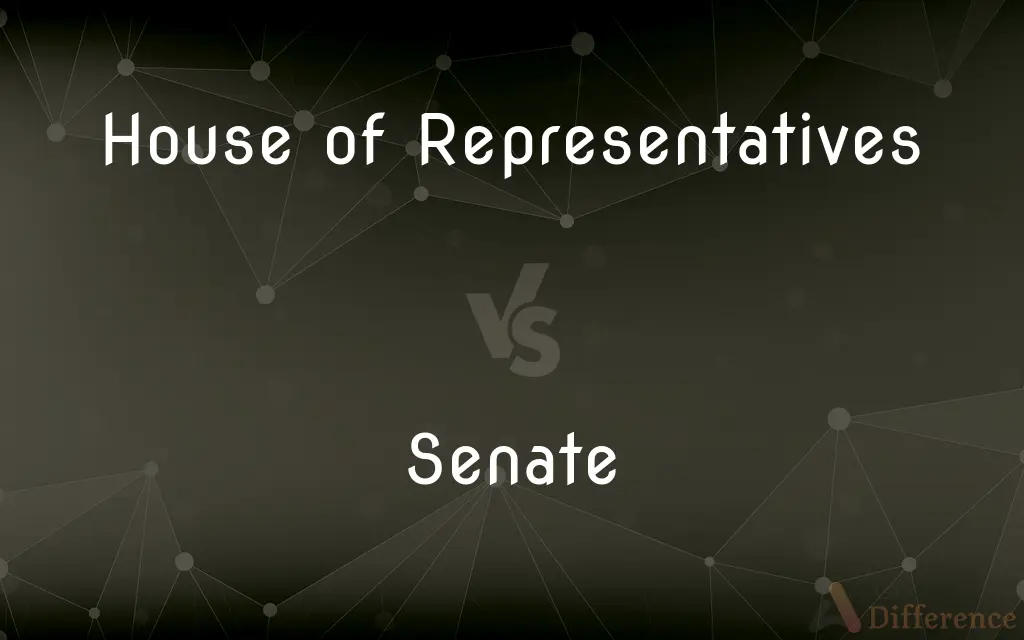House of Representatives vs. Senate — What's the Difference?
By Tayyaba Rehman — Published on October 31, 2023
The House of Representatives is the lower chamber of the U.S. Congress, based on population representation, while the Senate is the upper chamber with two senators per state, ensuring equal representation.

Difference Between House of Representatives and Senate
Table of Contents
ADVERTISEMENT
Key Differences
In the United States, the bicameral legislature consists of two chambers: the House of Representatives and the Senate. The House of Representatives is designed to give representation based on the population of each state. This means that larger states will have more representatives compared to smaller states. The Senate, on the other hand, is structured to ensure equal representation from every state, with each state electing two senators.
The House of Representatives, often referred to as the "People's House," is intended to be more responsive to the constituents due to its two-year term. In contrast, the Senate, with its six-year term, aims to provide stability and deliberation in the legislative process. The long term ensures that senators can make decisions without immediate electoral pressures.
Procedurally, there are differences between the House of Representatives and the Senate. For instance, revenue-raising bills must originate in the House, while the Senate has the exclusive authority to confirm or deny presidential appointments and ratify treaties.
Lastly, the leadership structures vary between the two. The House of Representatives is led by the Speaker of the House, while the Senate is presided over by the Vice President of the United States, with the Senate Majority Leader playing a pivotal role in steering the legislative agenda.
Comparison Chart
Basis of Representation
Population of each state
Equal, two per state
ADVERTISEMENT
Term Duration
2 years
6 years
Constitutional Powers
Originate revenue bills
Confirm appointments, ratify treaties
Leadership
Speaker of the House
Vice President (ceremonial), Senate Majority Leader
Size
435 members (varies by population)
100 members (two per state)
Compare with Definitions
House of Representatives
A body of elected officials representing districts within states.
Each district elects a member to the House of Representatives for a two-year term.
Senate
The upper chamber of the U.S. Congress with two members from each state.
The Senate has the power to confirm presidential appointments.
House of Representatives
The lower chamber of the U.S. Congress based on population.
The House of Representatives has the power to initiate revenue bills.
Senate
Part of the bicameral U.S. federal legislature.
The Senate collaborates with the House of Representatives to craft laws.
House of Representatives
The legislative chamber originating revenue bills.
All spending bills must begin in the House of Representatives.
Senate
A legislative body presided over by the Vice President.
In case of a tie, the Vice President casts the deciding vote in the Senate.
House of Representatives
A component of the bicameral U.S. legislature.
The House of Representatives works alongside the Senate to pass federal legislation.
Senate
A legislative body providing equal representation regardless of state size.
Each state, whether large or small, has two senators in the Senate.
House of Representatives
A chamber led by the Speaker of the House.
The Speaker of the House of Representatives is third in the presidential line of succession.
Senate
Senate The upper house of the US Congress, to which two members are elected from each state by popular vote for a six-year term.
Senate
Often Senate The upper house in the bicameral legislature of many states in the United States.
Senate
Senate The upper legislative house in Canada, France, and some other countries.
Senate
The supreme council of state of the ancient Roman Republic and later of the Roman Empire.
Senate
The building or hall in which such a council or assembly meets.
Senate
A governing, advisory, or disciplinary body of some colleges and universities composed of faculty members and sometimes student representatives.
Senate
In some bicameral legislative systems, the upper house or chamber.
Senate
A group of experienced, respected, wise individuals serving as decision makers or advisors in a political system or in institutional governance, as in a university, and traditionally of advanced age and male.
Senate
An assembly or council having the highest deliberative and legislative functions.
The senate was thus the medium through which all affairs of the whole government had to pass.
Senate
The upper and less numerous branch of a legislature in various countries, as in France, in the United States, in most of the separate States of the United States, and in some Swiss cantons.
Senate
The governing body of the Universities of Cambridge and London.
Senate
In some American colleges, a council of elected students, presided over by the president of the college, to which are referred cases of discipline and matters of general concern affecting the students.
Senate
Assembly possessing high legislative powers
Senate
The upper house of the United States Congress
Senate
The chamber with the authority to ratify treaties.
International treaties require the approval of the Senate.
Common Curiosities
What is the House of Representatives?
It's the lower chamber of the U.S. Congress, representing based on state population.
How long is a term in the House of Representatives?
Two years.
Which chamber originates revenue bills?
The House of Representatives.
How does the Senate differ from the House of Representatives?
The Senate offers equal state representation with two senators each, whereas the House is based on population.
How often are members of the House of Representatives elected?
Every two years, during even-numbered years.
Which chamber confirms presidential appointments?
The Senate.
What role does the Vice President play in the Senate?
The Vice President serves as the ceremonial presiding officer and casts tie-breaking votes.
What unique power does the Senate hold regarding international affairs?
The authority to ratify treaties.
How many members are in the House of Representatives?
435 members.
Who is third in the presidential line of succession?
The Speaker of the House of Representatives.
Who leads the Senate?
The Vice President ceremonially, with the Senate Majority Leader guiding the legislative agenda.
How many senators represent each state?
Two senators.
How are vacancies filled in the Senate?
Each state determines the process, often with a governor's appointment until the next general election.
Can a bill become law without both the House of Representatives and Senate approval?
No, both chambers must approve a bill before it goes to the President.
Is representation in the House of Representatives the same for each state?
No, it's based on state population, so larger states have more representatives.
Share Your Discovery

Previous Comparison
Manual Filing vs. E-Filing
Next Comparison
Data Masking vs. Data ObfuscationAuthor Spotlight
Written by
Tayyaba RehmanTayyaba Rehman is a distinguished writer, currently serving as a primary contributor to askdifference.com. As a researcher in semantics and etymology, Tayyaba's passion for the complexity of languages and their distinctions has found a perfect home on the platform. Tayyaba delves into the intricacies of language, distinguishing between commonly confused words and phrases, thereby providing clarity for readers worldwide.












































